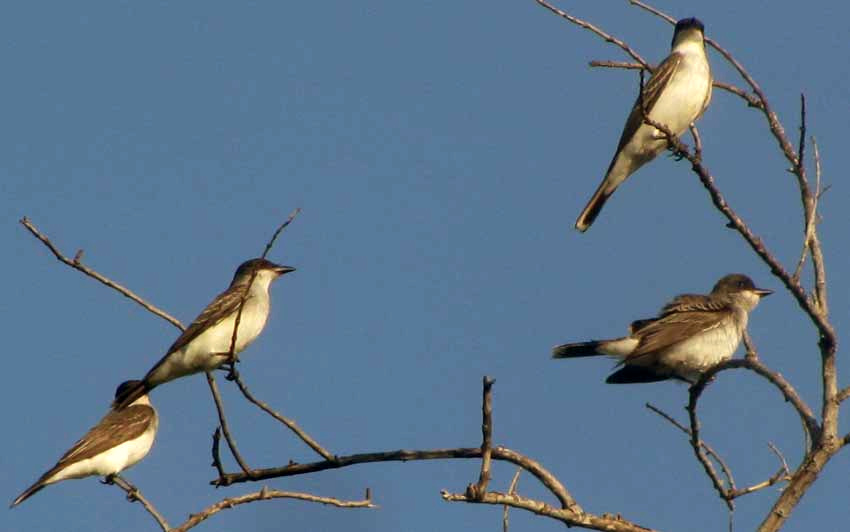Excerpts from Jim Conrad's
Naturalist Newsletter

from the September 18, 2011 Newsletter issued from Mayan Beach Garden Inn 20 kms north of Mahahual, Quintana Roo, México
KINGBIRDS GALORE
On Wednesday morning dozens of Eastern Kingbirds, TYRANNUS TYRANNUS, began winging past my window as the sun rose. They were easy to recognize because as my old Robbins field guide says, "No other songbird has a complete, broad, white terminal band on the tail."
Despite having seen so many pass my window, once I was biking on the white sand road I couldn't believe how many perched atop Hurricane-Dean-killed trees in the mangroves. That's four of them in morning sun above. Just for the novelty of it you can see maybe a couple dozen more in a typical dead tree top below:

The thing is, in the mangroves hundreds of such trees exist, and nearly all of them visible from the road were just as busy with Eastern Kingbirds as the one in that picture. Moreover, once I settled into the mangroves I realized that the head-tall Red Mangroves themselves were thick with kingbirds, most birds casually drifting from tree top to top, occasionally snapping an insect from the air with a sharp click of its beak. There were tens of thousands of birds, if not hundreds of thousands.
These birds are just passing through, though. They nest in most of forested North America, but overwinter in South America, passing through Mexico and Central America only during spring and fall migration.
from the April 28, 2002 Newsletter issued from the woods near Natchez, Mississippi, USA
TYRANNICAL EASTERN KINGBIRD
I always have to shake my head when I see a hawk streak zigzaggingly through the sky, chased by a Kingbird. Last Sunday afternoon I saw just that, a Broad-winged Hawk behaving as if a jet of the Mississippi State Airforce were after him, ducking and dodging in desperation. Yet the Eastern Kingbird is a good bit smaller than an American Robin and only a fraction of a hawk's size. It's just that Eastern Kingbirds are aggressive little birds. For good reason their Latin name is TYRANNUS TYRANNUS.
Kingbirds attack both hawks and crows. The assumption is that they evolved their behavior mainly because certain hawks prey on small birds, and crows are known to eat smaller birds' nestlings. This doesn't explain, however, why hawks and crows flee instead of fight. Why is this routine enacted again and again, century after century, the kingbirds chasing much larger crows and hawks? Maybe the answer will someday be presented in a precise mathematical equation. Yes, maybe this is yet another of those God jokes. I am finding more and more of them as time passes.